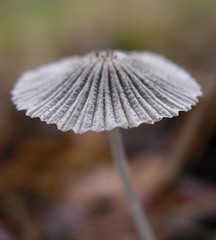 During my misspent youth and a fair bit of my adulthood, I steeped myself in more fantastic fiction that I care to admit. As one book rolled into another and another, a pattern began to emerge: When authors crafted their imaginary worlds, they tended to take one of two tacks. The first (exhibited to great effect by C.S. Lewis' Till We Have Faces and his Narnia series) borrowed tropes from ancient mythologies. The second involved expanding some extant reality until it became fantastic, such as transmuting ordinary winter frost into a frozen world of deadly ice magic (à la Fritz Leiber's "The Snow Women"). It's this latter approach that Jeff VanderMeer employs in Shriek: An Afterword, the second installment in his Ambergris trilogy, and the element he expands upon sounds impossibly bizarre on paper -- the subterranean workings of fungi, mold and rot.
During my misspent youth and a fair bit of my adulthood, I steeped myself in more fantastic fiction that I care to admit. As one book rolled into another and another, a pattern began to emerge: When authors crafted their imaginary worlds, they tended to take one of two tacks. The first (exhibited to great effect by C.S. Lewis' Till We Have Faces and his Narnia series) borrowed tropes from ancient mythologies. The second involved expanding some extant reality until it became fantastic, such as transmuting ordinary winter frost into a frozen world of deadly ice magic (à la Fritz Leiber's "The Snow Women"). It's this latter approach that Jeff VanderMeer employs in Shriek: An Afterword, the second installment in his Ambergris trilogy, and the element he expands upon sounds impossibly bizarre on paper -- the subterranean workings of fungi, mold and rot.Ambergrisians don't like to talk about the Silence, that period when 25,000 citizens of their city simply ... vanished. General consensus holds that the gray caps -- the fungus people who have always dwelled in the labyrinthine tunnels beneath the metropolis -- were responsible. Beyond that, any accord evaporates. That's why failed art promoter Janice Shriek has written this afterward to a travel guide penned by her brother, failed (and also missing) historian Duncan Shriek. He never held with the opinion that the gray caps were barely smarter than animals, an inferior life form meant to be mastered. Risking his reputation, health and the love of his life, Duncan dedicated himself to searching out the truth about Ambergris' original inhabitants, even if it meant travelling deep into their world, where strange spores and fruiting fungal bodies invaded his frame, granting him unheard of abilities even as they subsume him. Now Duncan is gone forever -- or is he? Because, reader, as you page through Janice's account you begin to notice marginal notes penned in his own hand ...
Admittedly, much of Shriek sounds as though it shouldn't work. Take its odd dual narration, Duncan's bracketed addenda inserted willy-nilly in Janice's "original" text. In truth, though, the two voices nearly always strike a harmonious tone, no doubt the result of careful composition on VanderMeer's part. And fungus as a fantasy element? Undeniably weird, but much like the gray caps' growths miraculously ravage Duncan's body, such speculation so suffuses the novel than its own internal logic emerges. Floating spores become multi-sensory surveillance systems for the gray caps. A quasi-biological machine, an abomination of metal and flesh strung together with mycological polyps, nearly drives Duncan mad when he beholds it underground. And molds visible only under certain spectrums of light reveal Ambergrisian buildings and byways tagged with countless cabalistic codes, "glowing and bold, in phosphorescent greens, yellows, reds, purples, blues." Add in subplots on the transience of artistic fame, the politics of publishing, the nature of religious belief, a humorously awful war, and the lasting impact of a parent's death, and you have a good book on your hands.
A good book, but not an easy one. Exposure to the trilogy's compendium-like first installment, City of Saints and Madmen, is almost a prerequisite. However, readers looking beyond the run of the mill will likely find the extra effort worth it. Shriek is truly the product of a fecund imagination.
(Picture: CC 2006 by petrichor)


No comments:
Post a Comment